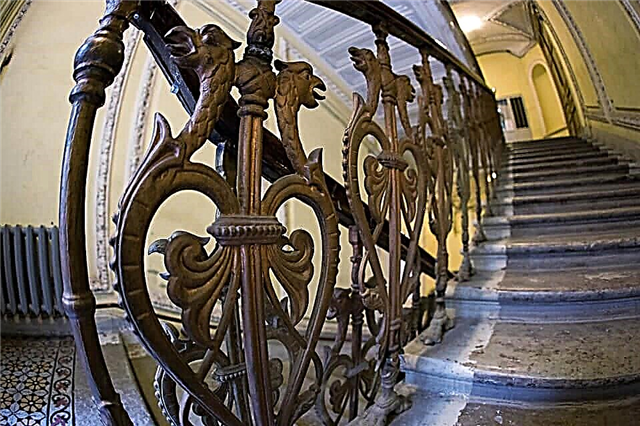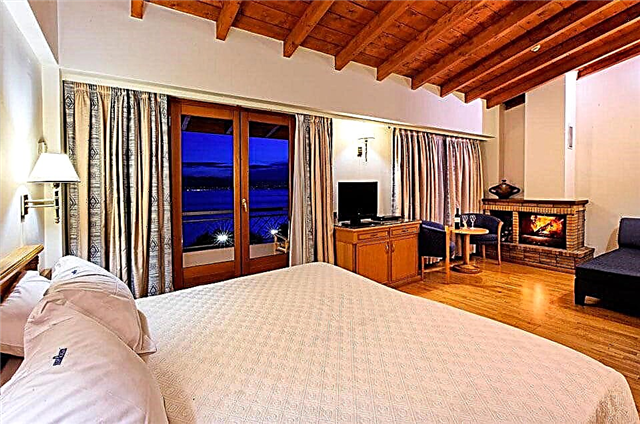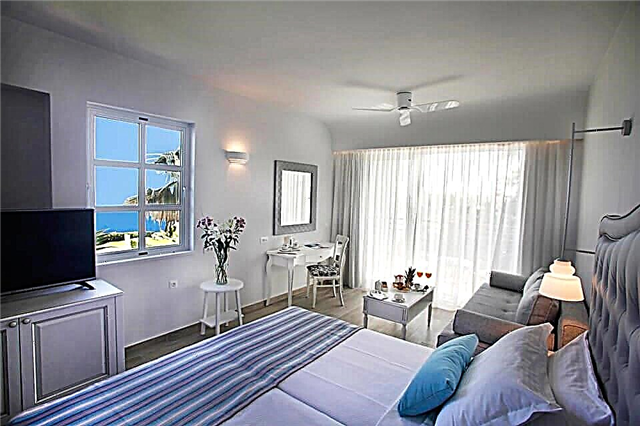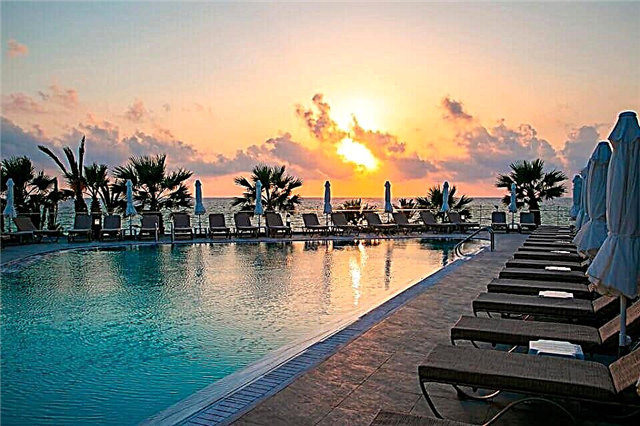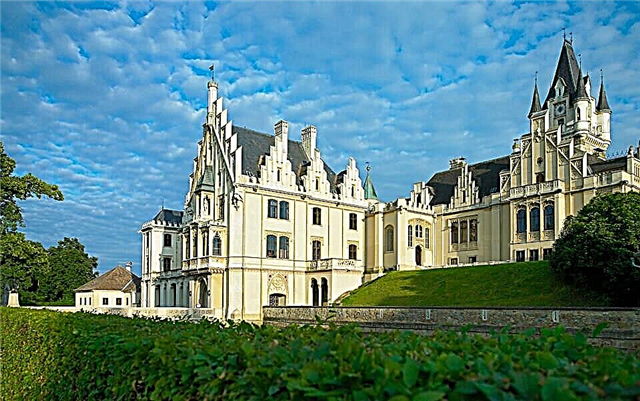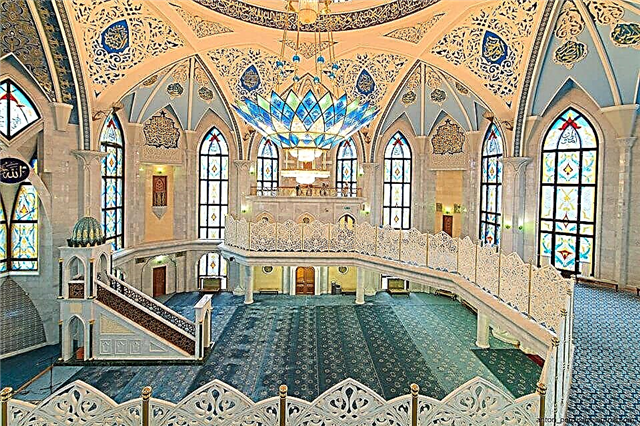The Kul Sharif Mosque in Kazan is part of the Kremlin ensemble and at the same time a place where services are performed. In full accordance with traditions, there is a library and the residence of the imam. And the museum invites everyone to get acquainted with the rich exposition. The Cathedral Mosque is a place where not only spiritual, but also secular life is in full swing. Master classes, conferences and lectures are held there. Not only Muslims can visit it, but also believers belonging to other confessions, as well as atheists.
Construction history

Do not break down, says popular wisdom. The cathedral mosque was destroyed in 1552, and no one wanted to restore it for more than 400 years. Meanwhile, according to the diary notes of the voivode Andrei Kurbsky, it was a majestic and beautiful structure. He described in detail the mosque before it was destroyed on the orders of Ivan Vasilyevich. In the 18th century, Catherine the Great visited Kazan, where she was delighted with a warm welcome in the Tatar settlement. In the Sukonnaya Sloboda, where the Orthodox lived, the queen was greeted more modestly.
The ban on the confession of Islam was lifted, the empress allowed the construction of cathedral mosques, but there was no question of restoring the destroyed mosque of the Kazan Kremlin. In Soviet times, the church was excommunicated from the state, the existing mosques were closed, and no one thought to return to the believers what Ivan IV Vasilyevich destroyed. It was only after perestroika and the collapse of the Soviet Union that the question of restoring the Kremlin mosque arose. The first President of Tatarstan Shaimiev supported the initiative of the Kazan public.
In November 1995, he decided to restore the Kremlin Cathedral Mosque. They began to collect money for the construction. The Russian President, Boris Yeltsin, responded and promised to allocate funds from the state budget, but this did not happen. At the same time, a competition was announced for the best mosque design. The team of architects won: Latypov, Sattarov, Sayfullin, Safronov. Andrei Kurbsky's diaries, which are kept in the state archive, helped them take into account the peculiarities of the historical appearance of the cathedral mosque in the Kremlin.

Over the period from 1996 to 2005, more than 400 million rubles were collected. Donated by individuals and organizations. This money was enough to restore the Kremlin Mosque and make it the religious and cultural center of Tatarstan. The first service in the new mosque was held on June 24, 2005. This event is a great gift to celebrate the 1000th anniversary of Kazan. The restoration of the mosque is a symbol of the revival of the age-old traditions of Tatarstan.
The constructed complex is more impressive and significant than the once destroyed structure. The building houses the residence of the imam, there is a library and a Muslim publishing house, and services are held in spacious halls. Visits to the mosque and the museum, which has been operating since 2006, are organized for tourists.
Name history

The mosque is named after Imam Seyid Kul-Sharif. This man is a significant person of the era of the collapse of the Kazan Khanate in 1552. Seyid Kul-Sharif was a direct descendant of the Prophet Muhammad along the line of the latter's grandson, Hussein. He came from the Crimean Seids, then served for some time in the Astrakhan Khanate, then returned to Kazan. But the mullah was appointed the supreme seid shortly before the fall of the khanate, in October 1551.
Seyid Kul Sharif was an educated and influential man of his time. Historical documents show that Russian princes regularly contacted him, negotiated and sent rich gifts. When Seid drove along Kazan street, the townspeople greeted him, and the rich Tatars did not hesitate to fall for his chapan. Even the khan dismounted in his presence. Seid was a creative person: several poems and a poem have survived to this day. Kul-Sharif is an expert in Russian and Tatar history.
He saw how the power of the Moscow principality grew, the army grew stronger, and his state was torn apart by internal contradictions. Seid is a few of those in power who envisioned a sad end to the state. The imam saw the real preparations of the Russian princes, assessed the threat to the khanate. He believed that only angels could help the Tatars in an unequal struggle, and there was nowhere to wait for real help.
Together with the Tyumen prince Bibars in 1551, he made attempts to force Ivan of Moscow to comply with the terms of the peace treaty of 1550. It is clear that this is only a temporary reprieve, but the diplomats tried to gain time. But the embassy turned out to be unsuccessful: Kul-Sharif and Bibars had to accept the next conditions of Moscow.
Kazan resisted the Russian army for 41 days. The city was defended by 30 thousand soldiers, and the Moscow prince commanded 150 thousand. Seyid Kul-Sharif was the mastermind of the defense: none of the townspeople thought about surrender. The last few days there was not a drop of water in the fortress: the scouts of Ivan of Moscow destroyed the water supply system.

Finally, of all the defenders, the boy-shakird and the imam survived. But they defended themselves so bravely that they overwhelmed the Russians. Voevoda Andrei Kurbsky wrote that the troops entered Kazan, stepping over the corpse of Sharikold. Seid with his troops retreated, fighting, climbed to the roof of the mosque, was stabbed to death and thrown down. The feat of the legendary Seyid was passed from mouth to mouth. It was also described by the philosopher Mardzhani. And in honor of the last defender of the state, the restored cathedral mosque in the Kazan Kremlin was named.
Architecture

The mosque is a unique structure. The complex consists of:
- 5-storey mosque. The ground floor is given over to the Museum of Islam, the technical one is occupied by services. There is a place for ritual ablution. On the ground floor there is a hall where men pray and an imam's office. On the second floor, women can pray, and there are areas for tourists. The advantage of the building: there are separate entrances for women and men.
- Fire department. It is a squat building south of the mosque with a blue roof. They are connected stylistically.
- Publishers and a unique library.
8 crescents (that is how many of them were at the mosque in the 16th century) of the mosque are directed to Mecca: orientation was carried out using a satellite. The height of each minaret is 57 m. The central dome rises to 36 m. The profile of the building is presented as an intersection of squares at an angle of 45 degrees: thus, the symbol of Muslims - the blessing of Allah - is recreated. The arches repeat the outlines of the nomads' yurts: the first Tatars had such mosques. On the dome, windows are carved in the shape of a tulip: a symbol of the Bulgars' rebirth.
The tulip is repeated in stained glass windows. The building is faced with light-colored stone, the domes are blue. All this should evoke a sense of purity, simplicity and purity. The thoughts of those looking at the mosque should be as pure as the building itself. 1.5 thousand Muslims can pray in the hall at the same time. Another 10 thousand can be accommodated in front of the mosque: the places for performing namaz are marked on the tiles with which the square is paved.
Interior

The inside of the mosque has a decent decoration. Here you can see:
- roman mosaic
- ganch (alabaster) carving
- gold embroidery
- painting made according to the technique of the 16th century
- ceramic panels made in the technique of the time of Imam Kul-Sharif
- baking stained glass windows
- stucco
- gilding
Coil, granite, onyx, marble were used for the work. Prayer carpets were sent by the Iranian government. A Czech crystal chandelier weighs 2 tons. Builders from Turkey worked on the construction of the mosque.
Mansion on Teatralnaya
Kazan
In a few minutes you can walk to Bauman Street and the Kazan Kremlin

Hotel Nogai
Kazan
300 meters from the Peter and Paul Cathedral

DoubleTree by Hilton Kazan
Kazan
5 minutes walk from the Kazan Kremlin

Interesting Facts

A few historical facts from the life of the one whose name the mosque bears:
- During the last embassy of the imam and prince Bibars, they offered Ivan of Moscow as hostage the queen Syuyumbike with her young son Utyamysh-Girey. The royal persons held at the Moscow court, according to diplomats, were supposed to ensure a long-term peace for the Russians and Tatars. The request was rejected, but maybe it was this historical fact that gave rise to the legend of the suddenly flared up passion of the Russian prince for the beautiful regent?
- After serving in the Astrakhan Khanate, Sharif received the additional name Khajitarkhani. Subsequently, he was called Amir, that is, the leader.
- You can get acquainted with the literary works of Kul-Sharif in the collection "Life is cruel, life is beautiful", published under the editorship of A. Sharipov in 1997.
The former Kremlin mosque was built in the 13th century, it was called Al-Kabir. The Cathedral Mosque is a new building, but there are already many interesting facts and legends:
- The dome of the mosque resembles a Tatar hat: only royal persons had the right to wear it.
- There is an opinion that the Kremlin mosque is the largest in Europe. But this does not correspond to reality: the delusion is generated by the significance of the reconstruction of the building for the Tatar people.
- It is symbolic that the residents of Tatarstan won the project competition. Their competitors were architects from Russia, Lebanon, Turkey.
Today the cathedral mosque is the spiritual center of the Muslims of the Volga region.
Visiting rules

In order not to offend the feelings of Muslims, when visiting a mosque, you must follow the rules:
- men and women should cover shoulders and legs
- before entering, you must take off your shoes or put on shoe covers
- women need to cover their heads with a scarf
- it is forbidden to move from the tourist area to the area for prayer
- it is forbidden to photograph praying Muslims
- it is recommended to visit the mosque at the set time
At the entrance, all tourists are offered to use free capes, scarves and shoe covers for all tourists.
Opening hours and ticket prices
The mosque is open to tourists every day from 9.00 to 18.00, on Fridays from 12 to 14 hours a break for prayer. From 17.30 the mosque is open only for exits. The entrance to the mosque is free, but a ticket is required to visit the Museum of Islam. For adults the price is 200 rubles, for other categories - 80 rubles. Visiting exhibitions and master classes is paid separately.
Where is it located and how to get there
The mosque is located at the following address: 420111, Russia, Republic of Tatarstan, Kazan, Kremlin, 13. You can get there by metro to the Kremlevskaya station, then on foot. By buses 6, 15, 35, 75, 29, 74 to the stops "Central Stadium", "TSUM", "Palace of Sports".

